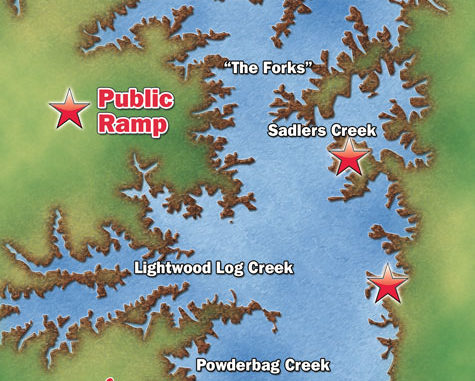
Pay attention to these guides’ tactics, and you’ll catch stripers on Lake Hartwell, even when it’s ‘too hot’ to fish.
Summer is here, and the fishing is hot. Everything is hot. The air is hot. The water is hot. Stand on the open deck of a boat at mid-day and pretty soon, you’ll be hot too. There’s no way you’re going to catch fish in this heat. Right?
Assuming that your boat is floating in the middle of Lake Hartwell, you look around and can’t help but feel a load of despair. You might be floating on 56,000 acres of bright, blue water but it looks and feels more like a desert.
If by chance you have a radio onboard, Jay “Stoneman” Stone, the mid-day deejay from WROQ, the local classic-rock station, might be playing one of his favorite songs: “A Horse With No Name” by the folk-rock band America. The song was intended to capture the feel of the hot, dry desert depicted in a Salvador Dalí painting, but it also gives the clues you need to turn your despair into success.
“The ocean is a desert with its life underground and a perfect disguise above….”
Now, imagine all that life a mere 70 feet below your feet. It’s a cool 68 degrees down there, and the lighting is dim, more like daybreak than mid-day. It’s a perennial spring day without cold fronts, high winds or any other weather assaults to spoil the fishing.
Bill Plumley, who guides for stripers on Lake Hartwell, may not be a classic-rock fan, but he agrees with the sentiments of the song.
“I know a lot of people claim it’s too hot to fish, but August and September are probably the most-consistent months I have here on Lake Hartwell,” he said. “You just gotta fish deep. Down there, things don’t change much from day to day, and I can almost always catch a limit of stripers and hybrids down on the main lake.”
Compared to other area lakes — Murray, Greenwood and even Clarks Hill — Lake Hartwell sets up differently during the hotter months when water tends to stratify.
On more fertile waters, the warmer water rises to the top, and the cooler water sinks to the bottom. The dividing line where the temperature changes over is the thermocline. On other lakes and even in Hartwell’s upper stretches, a hard thermocline is normal for this time of year. But for reasons that are not readily apparent, Hartwell’s main-lake basin tends to stay mixed, with quality water being available from 20 feet below the surface all the way to the bottom.
Preston Harden of Townville’s Bucktail Guide Service focuses most of his guide trips on Hartwell’s lower end so he doesn’t have to contend with thermoclines.
“The area from around Portman Shoals Marina down to the dam definitely has the best water quality when it gets hot,” he said. “I’ve noticed that in the years the thermocline sets up real hard in the rivers, it pushes fish further down the lake.”
By eliminating more than two-thirds of the lake, Harden can concentrate on his game plan for finding fish. The water in the main-lake basin can get as deep as 150 feet in places, and the distance across the lake can stretch a couple of miles, so even the lower lake can look like an ocean. In order to narrow the playing field, Harden concentrates on what he calls “the ditches” — submerged creek channels that meander across the lake floor and eventually connect with the Savannah River channel. Striped bass use these ditches as roadways to travel around the lake.
“This is a place that you’re going to have to rely on your electronics,” said Harden, “both for finding fish under the boat and for navigating over open water. There is a lot of water to cover. I never set up on a spot unless I see fish on the graph.
“I focus my efforts on three major creek channels: Sadler’s Creek, Powderbag Creek, and Lightwood Log Creek,” he said, “plus, there are a number of smaller ditches that run off of these major channels. It’s still a lot of ground to cover, but using a digital mapping system helps narrow it down. Most of the time, I can go right back to the general area I found them the day before, but if you haven’t been on the water in a while, you’ll need to do a lot of riding and looking before you pick a spot to fish.”
Catching fish is not the problem.
“Finding the fish is 90 percent of the battle,” said Plumley. “The hot weather cranks up a striper’s metabolism, and they definitely want to eat. I have days where I may spend half a day looking for fish, then have a 10-fish (per person) limit in the boat in just over an hour.”
There is a caveat in what seems to be a no-brainer fishing scenario — all the submerged timber that litters the lake floor, especially in the main lake. One problem fishing around trees is that it can be extremely difficult to tell on a depthfinder what is tree and what is fish. In addition, fishing in, around or over the trees can be fruitless.
“They are where they are,” Plumley said, referring to a striper’s affinity for underwater wood. “Some days they relate to trees and won’t leave them. It’s also very hard to determine what’s fish and what’s timber on the depthfinder, and that makes it tough. Those are usually the slower days — when the fish hold tight to the wood and you might hook them, but you rarely get them out of the wood without hanging up.”
“I’d much rather find them relating to a deep flat or a deep-water hump that has clean bottom,” Plumley said. “In fact, I believe they spend a lot of time in the trees, but when you find them on clean bottom it’s because they’re feeding. I have over 200 places marked on my GPS where there is open water adjacent to standing timber, so I’ve never made it a point to try to find them in the timber.”
Both Harden and Plumley rely on live bait, specifically blueback herring — which can be purchased at bait shops around the lake — to catch both striped and hybrid striped bass. Because of the extreme depths, typically 40 to 80 feet but possibly as deep as 100, the preferred tactic is a down-rod presentation. That requires a stationary boat, either at anchor or by using the trolling motor to hover over open bottom. A live herring is dropped to the depths on a Carolina rig, and multiple rods are staggered at the depths where fish have been marked. It usually doesn’t take long to get a bite.
“I only fish four rods at a time, one on each corner of the boat,” said Plumley. “Once they get going, it’s hard to keep up with just those four.”
Because of the hot water at the surface, it’s important to take care of your bait both on the way to your fishing holes and once it’s on the hook. Harden and Plumley have learned several tricks that help them keep their baits in top shape, and they agree that stripers won’t show much interest in a dead or dying bait.
“A good bait tank is a must,” said Harden. “Blueback herring won’t live long unless they are stored in a well-aerated bait tank, and you have to keep the water cool.”
“I go a little bit heavier on my Carolina rigs this time of year,” said Plumley. “I use a 2-ounce egg sinker in place of the usual 1½-ounce to get the bait down quicker. You really need to minimize the time between getting the bait from the tank, hooking it and getting it back down in the water. The worse thing is to dip the bait in the water and let him swim in that upper layer; the 80-degree water will put him in shock.”
If fish become active over clean bottom, it is possible to entice them to bite using artificial baits. Harden uses a technique he refers to as “power reeling.” Typically artificial baits work better after a school has been aroused with live baits.
When he’s fishing live baits, Plumley prefers a Kahle hook to the circle hooks that have become popular. Either way, he suggests that anglers don’t need to get in a big hurry to set the hook.
“I’ll put out my rods in rod holders and let the fish set the hook on themselves,” he said. “There’s really no need to get to the rod until it’s buried three guides deep in the water. Then the fight is on.”

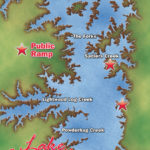
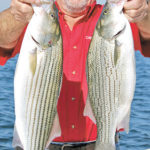
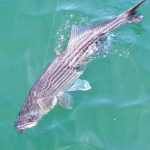
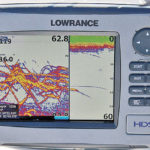
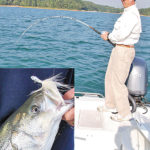
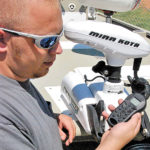



Be the first to comment